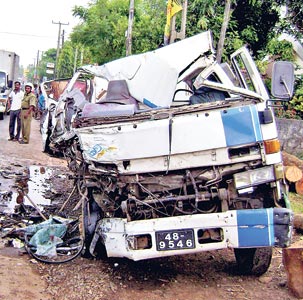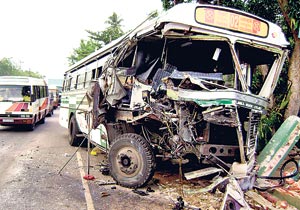| Stringent new laws are to be introduced this year to crack down on irresponsible road-users. The laws will cover, among other things, speeding, reckless driving, driving under the influence of alcohol, and using a mobile phone while driving.
The number of road traffic accidents – an alarming proportion of which result in fatalities, grievous injury and permanent maiming – has stayed at an unacceptably high level over the past few years, with a 10 per cent increase in the incidence of accidents observed since 2006.
A total of 2,069 fatalities caused by road traffic accidents was recorded in 2006, and the figure increased to more than 2,200 in 2009. The number of cases of grievous injury caused by such accidents has increased by between 300 and 400 in this period.
 |
| Motor accidents account for at least 50 per cent of deaths recorded at the Accident Service. |
 |
The spot fines system used by the Police will be scrapped, and offenders will be referred directly to the courts. The authorities believe that harsher punishments for traffic offences will help check and reduce the number of road accidents.
On January 25, 2008 the Supreme Court ordered traffic police officers to stop charging drivers for speeding, while ordering the removal of all incorrect speed limit signboards. According to the order, speed limit signboards have to be gazetted before they are put up, and the police have to be notified of the speed limits. Tickets for speeding are still being issued to motorists in certain parts of the city where the speed limit signboards have not been gazetted.
However, there appears to be some confusion between both the police and the motorists regarding the letter of the law and the speed limits given for different roads in different parts of the city. According to Government Gazette No: 853/14 of January 13, 1995, road speed limits, which are dictated by the Road Development Authority (RDA), are classified as A, B, C, D and E.
Under A and B, the speed limit for light vehicles, including cars and motorcycles, is 50 kilometres per hour in “built-up areas”, and 70kmph on roads outside built-up areas. The term “built-up” refers to towns surrounded by buildings. The speed limit for heavy vehicles is 50kmph, and 40kmph for land vehicles, including tractors.
The Supreme Court order was given in 2008, but the RDA has not yet gazetted the signboards. According to the Road Development Authority chairman R. W. R. Premasiri, the speed signs will be gazetted “soon”.
“Our road research findings are now with the legal draftsman, and the official gazetting will take place soon,” Mr. Premasiri told the Sunday Times. “The gazette has not yet been published. We are also taking steps to improve road conditions. The state of roads is crucial in preventing motor traffic accidents.”
Roads classified as C, D and E come under the local government authorities. According to the Motor Traffic Act, Section 140, the speed limit for light vehicles using these roads is 56kmph within urban areas, and 72kmph outside urban areas.
Here too, it has been found that the police rarely consider road classifications when they stop cars, while the motorists appear to be largely “ignorant” of the variations and differences in road speed limits.
Dr. Nihal Jayatilake, Secretary to the Ministry of Local Government and Provincial Councils, told the Sunday Times that it was not the Ministry’s job to oversee the putting up of road signs. However, the Provincial Road Development Authorities were on the job, he said. “We are not involved in the placing of signs. It is the task of the local road development authorities.”
It is understood that more than 3,000 signboards are required for all the main road networks, and that the cost for putting up these signs is estimated at more than Rs. 70 million.
The Ministry of Local Government and Provincial Councils last year conducted a survey on speed limits for roads. According to sources, the plan to put up the signboards has been held up, and there has been no report about progress on this matter.
According to the Geneva Convention on Road Traffic, all speed limits should be in round numbers, ending with a zero (“0”). This internationally recognised regulation is not observed in Sri Lanka. The lack of round numbers on road signs is no help to motorists, who have to keep a constant eye on their speedometers.
The Sunday Times understands that the Attorney-General has instructed the Police Department to charge drivers for driving at “dangerous speeds”.
The spot fine for excessive speeding is Rs. 1,000, while the court fine for driving at a “dangerous speed” is between Rs. 5,000 and Rs.7,500.
The fact that the Supreme Court New Law Reports (NLR) variously refer to “dangerous driving”, “driving in a dangerous manner” and “reckless driving” only adds to the confusion, making implementation of the law difficult and giving offenders loopholes to avoid harsh punishments.
According to the Supreme Court New Law Report (SC-NLR) 36, the act of dangerous driving does not necessarily mean exceeding the speed limit, unless accompanied by circumstances that render it dangerous.
The SC-NLR 30 defines “driving in a dangerous manner” as “driving in a manner likely to be dangerous to the passengers, other vehicles or persons on the road.”
The SC-NLR 31 defines “reckless driving” as “driving in a dangerous manner regardless of the consequences”, and is not considered the same as “negligent driving.”
Meanwhile, speed guns, which are used to monitor vehicle speeds, have also come under scrutiny lately. The police have been complaining of faulty speed guns, while motorists allege that road monitoring electronic equipment is not being properly used, and that untrained police officers are being put on the job of catching speeding motorists.
Speed gun accuracy is measured against standards decided by the Measurement and Services Division of the Department of Internal Trade. A certificate of accuracy on speed guns has to be issued every six months.
It has also been pointed out that only police officers of sergeant rank and above are authorised to nab speeding offenders.
It is understood that the police are seeking a refined set of laws that would help them to effectively curb the number of traffic accidents and traffic-related offences, while the road authorities are hoping for a greater awareness of road laws among motorists.
A refined and simplified set of rules and regulations would facilitate implementation, they say.
For the purpose of this article, the Sunday Times sought a meeting with the Motor Traffic Deputy Inspector General, Lucky Pieris, but was told that prior approval was required from the Police Media Spokesman.
Even after sending an official request to the police media spokesman – for a meeting with DIG Lucky Pieris and for statistics and police statements in regard to road speeding and related matters, the Sunday Times failed to have its request granted.
A perusal of the Police website shows that statistics on road traffic accidents were last updated two years ago, in 2008.
Meanwhile, road accidents continue to occur, and road casualty numbers continue to rise. Dr. Prasad Ariyawansa, director of the Accident Service at the National Hospital, told the Sunday Times that more than 50 per cent of recorded deaths at the hospital were caused by motor accidents.
This has been the case for several years now, he said.
“This is not a new problem,” Dr Ariyawansa said. “It has been going on for many years now. Last year, the Accident Service recorded 315 deaths, and more than half of these were caused by motor traffic accidents.”
Driving under the influence of ganja
One in every three bus drivers operating in the Western Province drive under the influence of ganja or marijuana, according to a survey conducted by the Private Bus Owners Association (PBOA). m
Long hours spent waiting at bus depots without work and irregular schedules are two reasons given to explain the widespread use of ganja among bus drivers and bus conductors.
According to PBOA president Gemunu Wijeyratne, most bus drivers spend hours at the depots, waiting for work, and that many of them spend their time smoking ganja, consuming alcohol, or gambling.
“It is not easy for the authorities to check these practices,” he said. “Ganja usage is hard to detect, even by the police.” Ganja usage among Western Province private transport staff is said to be highest in the Colombo, Gampaha and Kalutara Districts, and is comparatively low in the rural areas, according to Mr. Wijeyratne.
Police not forthcoming with accident facts and figures
Obtaining information and statistics from the Police Department has long been a problem for policy planners, research officers and the media.
Despite several efforts to get police figures and statistics for its report on motor traffic accidents and relevant action on the part of the authorities, the Sunday Times failed to get the information it required. The Police Department recently introduced a formal system for providing information.
In the past, the Police Department published all its statistics on motor traffic accidents in the media. This benefited policy planners, research officers and decision-making officers alike. These statistics were also published by the Census and Statistics Department in its annual report. However, this information has not been available in recent years.
When asked, police officers say they are under orders not to provide such information to the media. |



